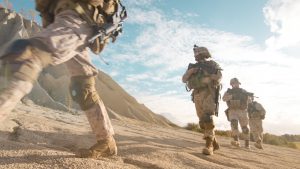Catherine Putz

For much of the last 20 years of war in Afghanistan, it was the country’s south that drew attention. Kandahar, the country’s second-largest city and capital of a vast southern province of the same name, was the last Taliban-held major city to fall in 2001. Afghanistan’s south and east, along the Pakistan border, have over the years been consistently described as Taliban strongholds. The north, meanwhile, had since the onset of civil war in the early 1990s been a bastion of resistance to the Taliban.
As the war jolts into its next phase, with the United States’ withdrawal nearly complete, conflict has intensified in the country’s north.
Writing for the Afghanistan Analysts Network recently, Kate Clark and Obaid Ali characterize the surge in attacks in Afghanistan’s north as looking “like an attempt to prevent a ‘second resistance’ from being established.”
According to their analysis, from May 1 to early July, the Taliban had captured more than 60 districts across nine northern provinces. Some districts fell easily and others have been captured and recaptured multiple times. That trend has continued. For example, the Taliban captured Khanabad district in Kunduz on June 14, but it was soon after recaptured by government forces; a new assault on June 16 saw the district change hands again, followed by a counterattack by Afghan government forces on June 21. Further west, the capital of Badghis province, Qala-e-Naw, fell into Taliban hands on July 7 before returning to government control several hours later, with fighting ongoing.
Many news stories lead with headlines that Afghanistan’s north is falling. The overarching narrative suggests the Taliban are on an unstoppable march to victory, but the back-and-forth taking and retaking of districts and cities indicates Afghan forces are not completely defeated. They are, however, under extreme pressure.
Clark and Ali recount the relevant history, placing the latest push by the Taliban in the north in context: “In the late 1990s and early 2000s, after the Taleban [sic] had taken much of the country with barely a fight, opposition to the movement was the strongest and most enduring in the centre and north of Afghanistan.” While one former senior official pointed out that there is heavy fighting in 26 of Afghanistan’s 34 provinces, they write that “the efforts the Taleban have put into the north suggest a well-planned and executed pre-emptive strike.”
They link this to the wave of assassinations of “public intellectuals” in Kabul and elsewhere in Afghanistan, as setting the ground and making military sense if the Taliban were aiming to take such centers of opposition. It also helped generate a pervasive sense of fear and insecurity, not entirely unwarranted given the circumstances, which feeds a defeatist narrative.
None of this is unforeseen. In a 2009 report for the Carnegie Endowment for International Peace, titled “The Taliban’s Winning Strategy,” Gilles Dorronsoro wrote that the NATO coalition’s focus on the south of Afghanistan was “unwise”:
The lack of local Afghan institutions there will require a long-term presence and therefore a need for even more reinforcements in the coming year. Meanwhile, the pace of Taliban progress in other provinces… far outstrips the ability of the Coalition to stabilize the South. The Coalition should change the priorities of its current strategy, shifting resources to stop and reverse the Taliban’s progress in the North, while reinforcing and safeguarding the Kabul region or risk losing control of the entire country.
Dorronsoro argued that the coalition could not beat the Taliban in the south and east, or rather that the coalition was not going to commit the kind of forces necessary to do so; therefore, it would be better served by focusing on where gains could be made: “The biggest mistake is to concentrate reinforcements in the South, while failing to react quickly and decisively to stop Taliban inroads in the North, where success now would be readily achievable.”
In 2010, coalition forces — then at their height numerically — made a major push in Kandahar, with news reports characterizing it as an effort aimed at the heart of Taliban country and a “last chance to win over Afghans.”
More than a decade later, here we are: The Taliban are exerting pressure in Afghanistan’s north in a strategic push aimed at not just military objectives, but narrative objectives, too. On the one hand, taking the north addresses the Taliban’s fear of it becoming a bastion of resistance to their rule once again; on the other, even if the Taliban cannot consistently hold parts of the north, the violence serves their purpose in positioning the Afghan government, and its forces, as weak and ineffective. It has always been easier to destroy something than protect it.
Importantly, Clark and Ali close with this: “As always in Afghanistan, it is the weakness of the government, not the strength of the armed opposition, which has decided whether territory in Afghanistan falls.”
No comments:
Post a Comment